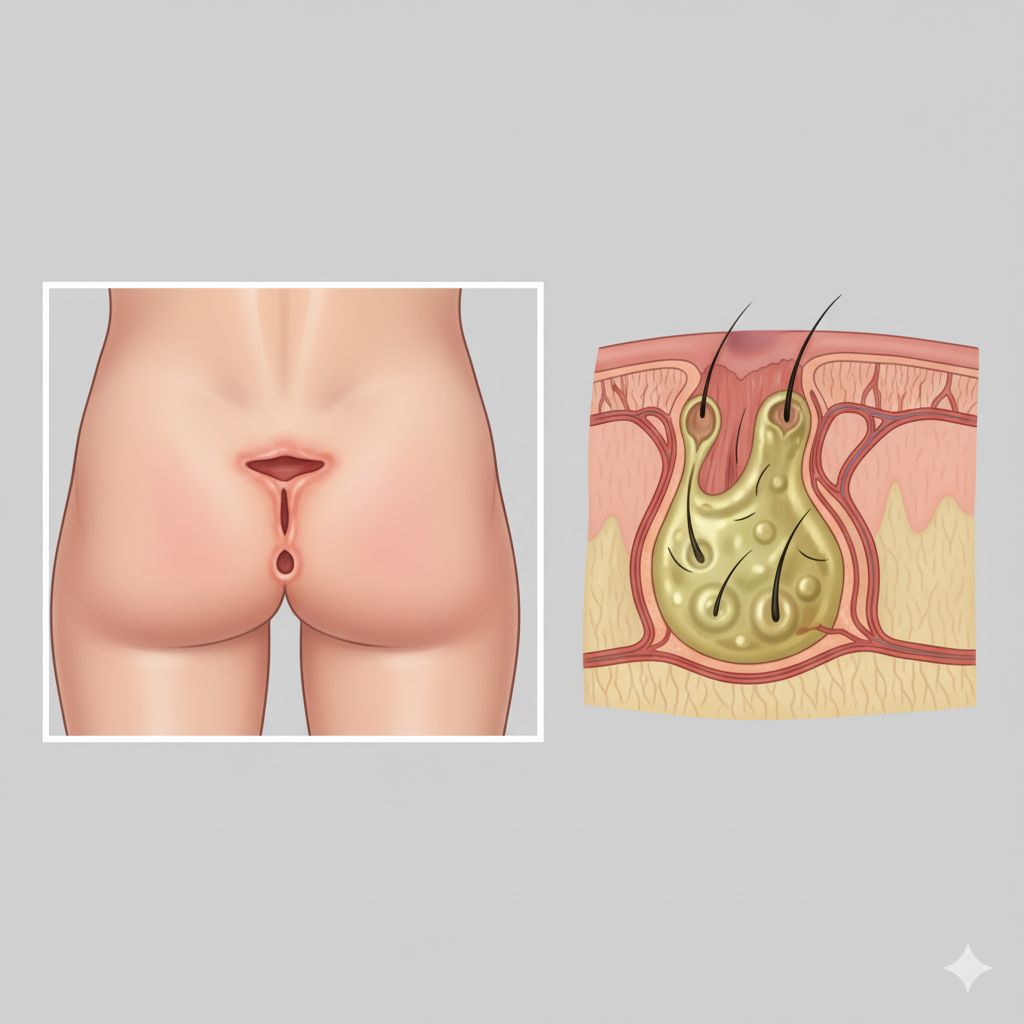Pilonidal Sinus: Symptoms, Causes and Treatment Options
What is Pilonidal Sinus?
A pilonidal sinus is an infection and cyst formation that occurs when loose hairs penetrate the skin, particularly in the sacrococcygeal (tailbone) region. Also known medically as pilonidal sinus or sinus pilonidalis, it occurs when hairs shed from the back or buttocks become embedded in the intergluteal cleft (the groove between the buttocks), causing an infection beneath the skin. This process may lead to abscess formation, fistulas, and the development of a hair-containing cyst.
History of Diagnosis
Pilonidal disease was first described in 1833. Although it was thought to be a congenital condition in the 1950s, it is now recognized as an acquired disease.
Who Gets Pilonidal Sinus Disease?
- Most common in young males between ages 16–30
- More frequently observed in individuals with coarse body hair and those slightly overweight
- Affects around 10% of men in Türkiye
- More common among Caucasians; rare among African and Asian populations
- Rare after the age of 40
What Are the Causes of Pilonidal Sinus?
Pilonidal sinus forms when shed hairs penetrate the fatty tissue of the sacrococcygeal area due to friction and sweating. These hairs are perceived by the body as foreign objects, triggering an inflammatory response. The most widely accepted theory belongs to Karydakis, who identified three main factors: the hair (causative agent), friction (driving force), and skin structure (depth of the natal cleft).
Risk Factors Contributing to Pilonidal Sinus
- Occupations requiring prolonged sitting (drivers, secretaries, bank employees, etc.)
- Excessive friction in the buttock area
- Heavy sweating
- Swelling and poor hygiene
- Local Trauma
- Individuals with a history of boils or abscesses are also at higher risk.
Why Is Pilonidal Sinus Most Common in the Tailbone Area?
The sacrococcygeal region, located between the buttocks, is closed, sweaty, and prone to friction—conditions that make it easier for loose hairs to penetrate the skin. Since the skin here is more sensitive and easily irritated, the risk of infection is higher.
What Are the Symptoms of Pilonidal Sinus?
- Swelling or painful lump in the tailbone area
- Itching and discomfort
- Small openings in the skin (sinus pits)
- Discharge or bleeding
- Occasional abscess formation
Can Pilonidal Sinus Occur in the Anal Area?
Although rare, perianal pilonidal sinus (hair cysts around the anus) can occur. This may develop in three ways:
- The pilonidal sinus may progress downward and reach the anal region.
- Hair may migrate into an existing anal fistula.
- A new sinus tract may form near the anus due to embedded hair.
What Conditions Can Be Confused with Pilonidal Sinus?
When diagnosing pilonidal sinus, the following conditions should be ruled out:
- Perianal fistula
- Skin boils and abscesses
- Syphilitic lesions (granulomas)
- Inflammation of the coccyx bone (osteomyelitis)
How Does Pilonidal Sinus Develop?
An inflamed hair follicle turns into a folliculitis or furuncle. Over time, the hair follicle ruptures under the skin, forming a pilonidal abscess. Once the abscess opens to the surface, it becomes a sinus tract. If hair enters the sinus, the body cannot expel it, and a cycle of infection begins internally.
What Happens at Advanced Stages?
Sinus openings are usually located 5–8 cm above the anus. In rare cases, sinus tracts may tunnel downward and create tracts closer to the anal region. These tracts may not be linear—they can extend sideways as well.
What Happens If Pilonidal Sinus is Left Untreated?
If left untreated, pilonidal sinus becomes chronic. Recurrent abscesses, inflammation, and foul-smelling discharge are common. Patients often withdraw from social life. More importantly, though rare, long-standing chronic pilonidal sinus cases may lead to epidermoid cancer. Although only 44 such cases were reported in the literature between 1900 and 1994, awareness is crucial.
How Is Pilonidal Sinus Treated?
Early-stage cases can be managed with shaving, hygiene, posture correction, and antibiotics. However, the only permanent solution is surgical treatment.
Surgical Options
- Sinusectomy: Removal of the sinus tract only
- Flap Procedure: After excision, the skin is shifted to close the sinus cavity
- Minimally Invasive Techniques: Phenol application, laser therapy, etc.
Conclusion
Pilonidal sinus is a condition frequently seen in young men. If left untreated, it may lead to serious infections and significantly decrease quality of life. However, early diagnosis and appropriate treatment can improve outcomes and enhance quality of life.


